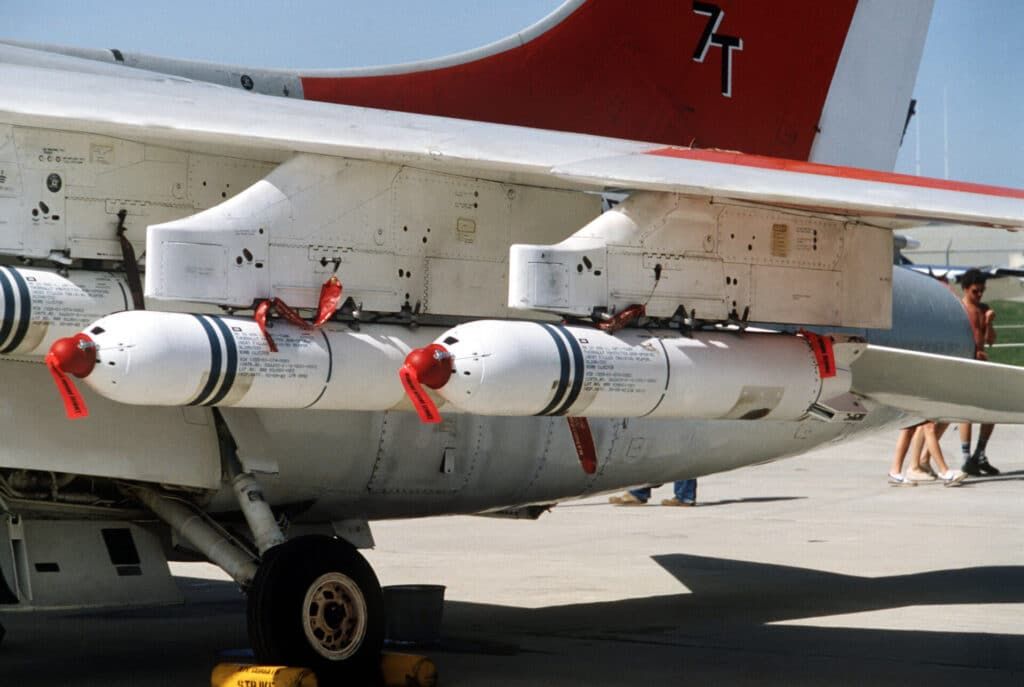Why the United States should prioritize autonomous demining technology
By Amy J. Nelson | May 17, 2023
 CBU Mark 20 Mod-6 Rockeye cluster bombs mounted on a LTV A-7E Corsair II fighter at Naval Air Station Patuxent River, Maryland (USA), on 13 May 1984. Credit: Don S. Montgomery, USN, Public domain, via Wikimedia Commons
CBU Mark 20 Mod-6 Rockeye cluster bombs mounted on a LTV A-7E Corsair II fighter at Naval Air Station Patuxent River, Maryland (USA), on 13 May 1984. Credit: Don S. Montgomery, USN, Public domain, via Wikimedia Commons
Recent calls for sending cluster munitions to Ukraine are growing louder on Capitol Hill. A letter from leading Republicans to President Joe Biden last month strongly supported Ukraine’s request for more lethal aid, particularly cluster munitions, which consist of a container or dispenser from which many submunitions or bomblets are scattered over wide areas from the air. There are strong reasons for deciding not to transfer cluster munitions to Ukraine, but if the United States does decide to provide these weapons, it should keep a few lethal realities in mind.
First, cluster munitions are inhumane because of their impact on civilians and high dud rate relative to other types of munitions, leading to post-conflict detonations. Because unexploded cluster munitions can become embedded in the ground like landmines, they kill a great number of civilians (particularly children) who come into contact with them, unknowingly triggering unexploded bomblets by pressure or even mere proximity. Civilians who encounter landmines by directly stepping on them are usually killed. Less commonly, they suffer foot or leg injuries which lead to amputation and/or secondary infections. [1]
Also, cluster munitions are Cold War-era weapons; in recent years, the United States began planning upgrades designed to make them “safer” by improving their precision, reliability, and self-destruction features, all aimed at reducing civilian harm. Despite efforts to create smarter cluster bombs equipped with these safety upgrades, “dumb” cluster bombs are still widely used. It is likely the US stockpile in question is of the dumber persuasion.
Not only are the weapons themselves barbaric and obsolete, the process of removing unexploded cluster-bomb “mines” is also stuck in the past and lacking in digital upgrades. Demining and autonomy are a natural pairing; the addition of autonomous systems to demining processes could be low-cost and relatively easy. But such systems—using, for example, drones to survey large stretches of land and plot maps of mine locations—have not been developed to scale or standardized. If the United States does make the lamentable decision to transfer cluster munitions to Ukraine, investments in autonomous capabilities for aspects of the demining process—including the identification and mapping of mines and other explosive remnants of war—must take priority.
A call for munitions. Since late 2022, and as ammunition stockpiles in the West run dangerously low, Ukraine’s Ministry of Defense has been requesting MK-20s (aka CBU-100s), a Cold War-era, air-delivered cluster munitions system, from the United States. Rather than deploy these munitions from manned aircraft as has traditionally been done, Ukraine seeks to deliver them via drone, as a tactic to counter Russia’s-own human wave tactics, matching gruesomeness in kind. Ukraine’s proposed use of these older systems is admittedly a creative way of adapting to a munitions-starved environment while fighting for Ukrainian lives. Also, because these weapons are far from cutting-edge military technology, the United States may consider their transfer to Ukraine “non-escalatory.”
To date, the White House has not been persuaded by lobbying for such a transfer. US National Security Council spokesperson John Kirby said in response to Ukraine’s request in December of 2022: “According to our own policy, we have concerns about the use of those kinds of munitions.” Kirby’s statement appears to acknowledge the future risks to Ukraine from cluster munitions—and perhaps offers a nod to the international community that has condemned them, a condemnation that the United States has not officially joined. Indeed, cluster munitions cause such egregious suffering, they are subject to arms control regulations: Parties to the 2010 Convention on Cluster Munitions commit to not using, producing, stockpiling, or transferring cluster munitions and also to destroy preexisting stockpiles of munitions. More than 120 countries have ratified the convention. Notably, neither Ukraine nor the United States has ratified the it, although both have acknowledged the humanitarian concerns associated with cluster munitions. Russia, meanwhile, claimed it could not join the convention because it views cluster munitions as legitimate weapons despite their humanitarian risks.
If the White House ultimately supports this warfare regression—pulling weapons from another era that have been deemed inhumane out of the crypt—the upside is that artificial intelligence can make cluster munitions less dangerous to civilians over time. There is an opportunity to “use AI for good” by investing in and providing autonomous demining systems for the demining operations that must inevitably follow.
Innovation interrupted? The post-conflict demining process generally follows a protocol that begins with a technical survey and mapping of an area before continuing on to mine clearance, marking, post-clearance documentation, community liaison, and the handover of cleared land. Autonomous systems are a natural fit for mine clearance; they can replace the use of human beings, dogs, and rats in the iterated pattern of identification, deactivation, and removal that chadracterizes demining. But the foundational research on precisely how to do this remains at the most basic stage, primarily focused on detection rather than removal and disposal, with efforts at innovation largely residing in the private sector and yet to be scaled up.
Unmistakably, the United States is highly attuned to the need for clearing landmines and the problems posed by cluster munitions in general and specifically in Ukraine. As of August 2022, it pledged $89 million in demining assistance for Ukraine alone, which includes funding for providing demining training to Ukrainian soldiers. The United States has invested over $4.2 billion in clearing landmines, explosive weapons of war, and excess small arms/light weapons and munitions worldwide from 1993 to 2022. The lack of contemporary technology, including autonomous systems for demining, is a glaring omission from the US mine-clearing toolkit.
The dearth of autonomous technology means that demining remains risky to humans and inefficient. The United States initiated a research and development program in the Army to develop new technology for demining in 1994, but little progress has been made. A 2022 report from the State Department reveals that US peacekeeping operations continue to repurpose commercial off-the-shelf equipment and technologies for use by the US Army Humanitarian Demining Research Development Program.
Perhaps signaling the importance of demining to the United States, the State Department releases an annual report on best practices in the areas of mine detection, clearance, and neutralization, emphasizing diplomacy as a way of advancing efforts to demine. A 2021 US Army report focuses more on technology, detailing the United States’ deployment of armored excavators that can be controlled remotely and, when in controlled manually, can protect the operator from harm. A prototype of an autonomous robot that removes mines once a deminer has determined the buried landmine’s location and marked it with spray paint does exist. The robot identifies the paint colors, positions itself, and digs up the mine—but the use of robotics in mine identification has not been scaled up. Robotic demining at scale would be more expensive than current methodologies.
Remote sensing technologies that can identify mines would likely be less expensive to scale up. These technologies would require additional investment to improve the algorithms they use to identify mines, however: They currently deliver a high rate of false positives in detecting landmines and unexploded ordnance. Once this technological problem is solved, flying drones and satellites could provide images for AI analysis on a comparatively inexpensive basis.
Autonomy for demining = AI for good. As horrifying as it is, the resurrection of cluster munitions for use by Ukraine might be justified—if it were the only way to save Ukrainian lives. But these weapons are banned in most of the world, and a decision to use them to counter Russian massed attacks and defenses in depth requires careful consideration. Any US program that sends cluster munitions to Ukraine must be accompanied by plans for minimizing civilian casualties during and after the conflict. Investments in and development of technologies for autonomous demining operations, post war, are long overdue and consistent with the White House’s push for a Blueprint for an AI Bill of Rights, which vows to use autonomy for the public good. Alas, while the Defense Department has pursued autonomous systems for the battlefield and the unincentivized private sector has focused on producing dancing robotic dogs, efforts to develop autonomous demining technology have stagnated. The United States should provide funding to energize those efforts, regardless of what decision is made in regard to sending cluster bombs to Kiev.
[1] In 2019, 5,545 people were victims of landmines, and 2,200 of those victims were killed; in 2020, there were 7,073 reported victims (1,872 were children), with 2,492 killed (645 children).
Together, we make the world safer.
The Bulletin elevates expert voices above the noise. But as an independent nonprofit organization, our operations depend on the support of readers like you. Help us continue to deliver quality journalism that holds leaders accountable. Your support of our work at any level is important. In return, we promise our coverage will be understandable, influential, vigilant, solution-oriented, and fair-minded. Together we can make a difference.
Keywords: Convention on Cluster Munitions, Russia-Ukraine, Ukraine, bombs, warfare
Topics: Disruptive Technologies














